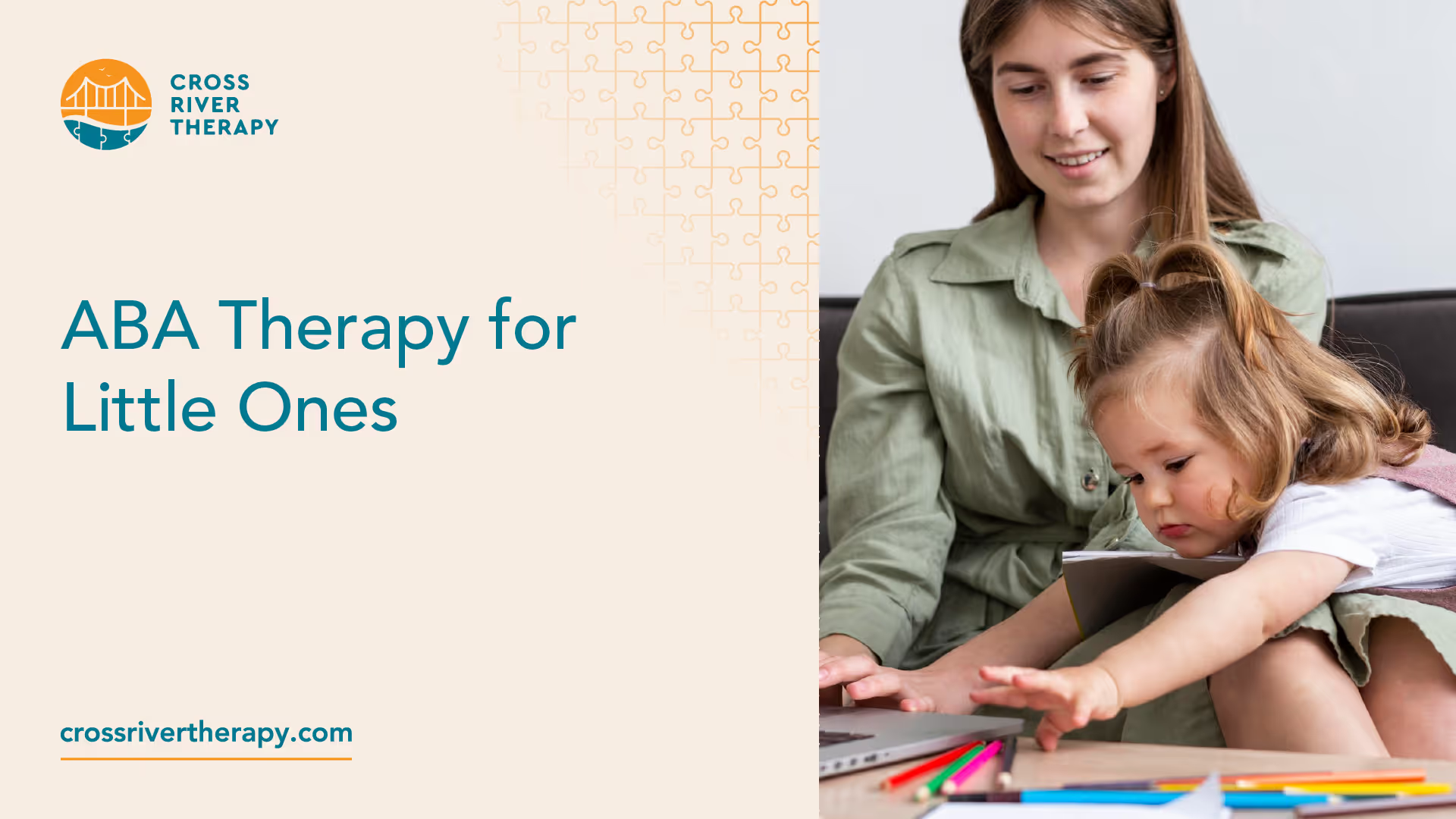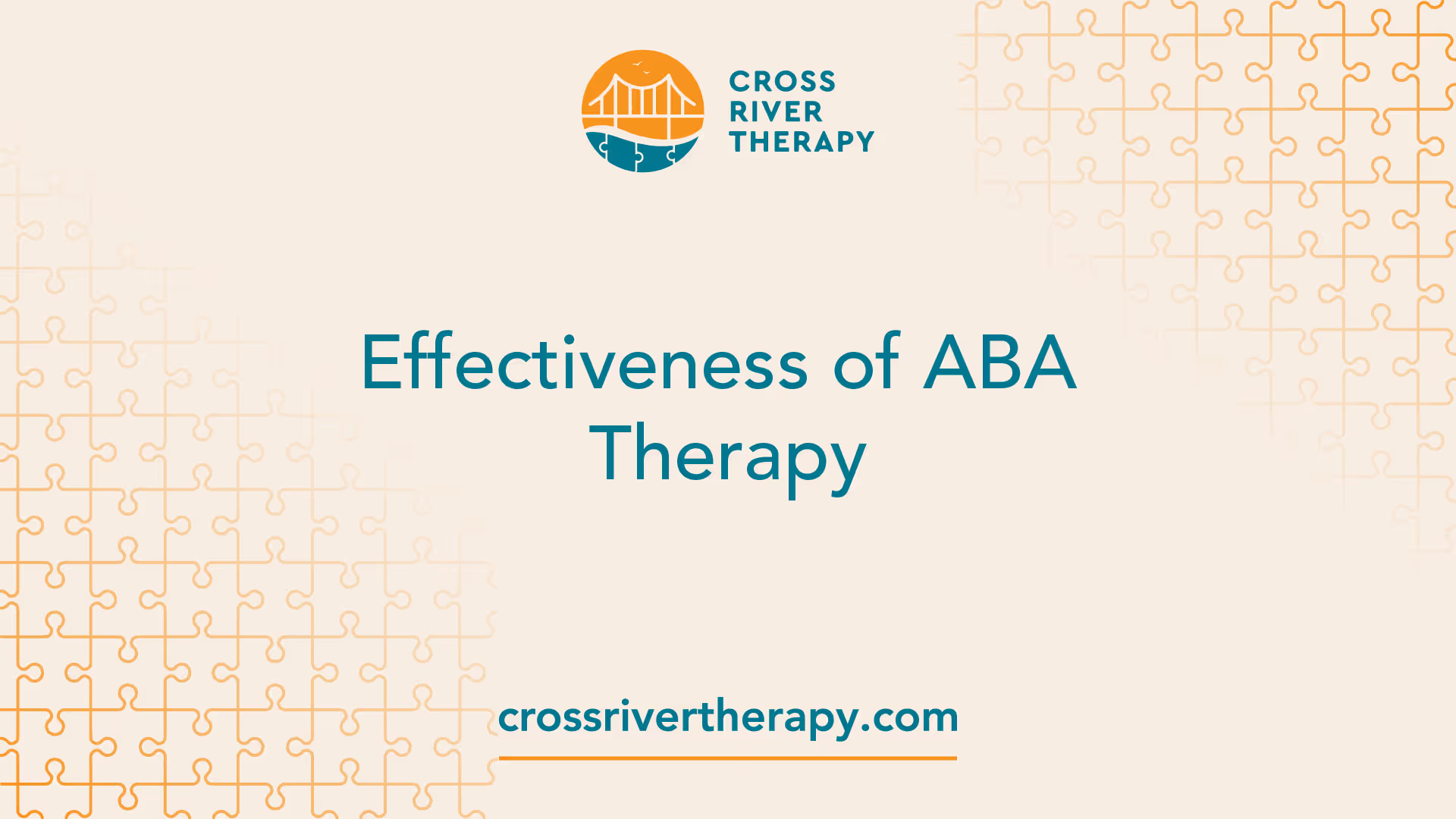ABA Therapy for Little Ones
Discover effective techniques and benefits for your little one with autism.
Understanding ABA Therapy for Toddlers
ABA therapy, or Applied Behavior Analysis therapy, has shown significant benefits for toddlers diagnosed with autism spectrum disorder (ASD). Starting ABA therapy as early as possible is generally considered most effective, typically between 2 and 6 years old, but can even begin as young as 18 months [1]. Early intervention allows for the timely improvement of communication skills and daily living skills, preparing toddlers for a positive preschool experience.

Introduction to ABA Therapy
ABA therapy is a scientifically validated approach that focuses on understanding behavior and how it is influenced by the environment. The goal of ABA therapy is to improve socially significant behaviors and decrease behaviors that may interfere with learning and development. It is a personalized therapy that targets specific goals based on the needs of each toddler.
ABA therapy utilizes various evidence-based techniques that are tailored to the individual child. These techniques are designed to teach new skills, promote positive behaviors, and reduce challenging behaviors. ABA therapists work closely with families to develop intervention plans that address the unique needs of each toddler.
Evolution of ABA Therapy
ABA therapy has evolved over time to become a comprehensive and effective treatment for individuals with ASD. Initially developed in the 1960s and 1970s, ABA therapy focused primarily on behavior modification. It involved breaking down complex behaviors into smaller, manageable steps, and reinforcing positive behaviors while minimizing or eliminating challenging behaviors.
Modern approaches to ABA therapy have expanded beyond behavior modification to include a focus on building relationships, promoting social interaction, and teaching essential life skills. Therapists now incorporate natural environment teaching (NET) and discrete trial training (DTT) techniques to maximize learning opportunities for toddlers with ASD.
During ABA therapy sessions for toddlers, therapists prioritize building a positive relationship through play and identifying the child's reinforcers. They work closely with board-certified behavior analysts to establish specific goals and create a personalized intervention plan. ABA therapists also create opportunities for social interactions and teach daily living skills to enhance the overall development of the toddler [2].
Understanding the introduction and evolution of ABA therapy provides a solid foundation for comprehending its benefits and the considerations involved in implementing this therapy for toddlers. In the following sections, we will explore the debates surrounding ABA therapy, its effectiveness, and the important role of behavior analysts in designing and implementing ABA programs for toddlers.
Debates Around ABA Therapy
While Applied Behavior Analysis (ABA) therapy has proven to be effective in helping children with autism learn new skills and reduce problematic behaviors, there have been debates and criticisms surrounding the therapy. It is important for parents and caregivers to be aware of these debates to make informed decisions regarding their child's treatment.

Criticisms of Traditional ABA
One criticism of traditional ABA therapy is that its earliest form involved the use of punishments alongside rewards. Although punishments are no longer a part of ABA, some critics argue that the therapy can still be too repetitive and demanding on children. They express concerns that the therapy may not take into account the individual needs and preferences of autistic children.
Another criticism is that ABA therapy has been overly focused on eliminating behaviors rather than building skills. Some argue that this approach does not fully address the needs of autistic individuals and may not align with their unique strengths and abilities. However, proponents of ABA highlight that modern approaches to therapy often prioritize making learning enjoyable for the child and emphasize skill-building rather than solely focusing on behavior reduction.
Modern Approaches to ABA
In response to the criticisms of traditional ABA, modern approaches to therapy have emerged, addressing the concerns raised by critics. These approaches aim to make ABA therapy less repetitive and more enjoyable for the child. Therapists are trained to create a positive and engaging learning environment, tailoring the therapy to the individual needs and preferences of each child.
Proponents of modern ABA therapy argue that it is essential to focus on what children should be doing rather than solely concentrating on what they should not be doing. This shift in focus allows therapists to help children develop the necessary skills for independence and success in various areas of their lives.
It's important to note that there are differing perspectives within the autism community regarding ABA therapy. Some autistic self-advocates argue that ABA aims to make autistic children conform to neurotypical standards, which may not align with the unique needs and strengths of autistic individuals. They suggest alternative therapies, such as speech and language therapy, which focus on developing communication skills and promoting independence [3].
As a parent or caregiver, it is crucial to consider these debates and engage in open discussions with professionals in the field to determine the most suitable therapy for your child. Understanding the criticisms and modern approaches to ABA can help inform your decision-making process and ensure that your child receives the most beneficial and appropriate interventions for their individual needs.
Effectiveness of ABA Therapy
ABA therapy has been extensively studied and proven to be an effective intervention for children with autism. Research has consistently demonstrated the positive impact of ABA therapy on various aspects of a child's development. Let's delve into the research on ABA therapy and explore its numerous benefits.

Research on ABA Therapy
More than 20 studies have established that intensive and long-term therapy using ABA principles improves outcomes for many children with autism. These programs typically provide 25 to 40 hours of therapy per week for 1 to 3 years. The research shows that such intensive therapy leads to significant gains in various areas, including:
- Intellectual functioning
- Language development
- Daily living skills
- Social functioning
ABA therapy is considered an evidence-based best practice treatment by the US Surgeon General and the American Psychological Association. These endorsements highlight the rigorous scientific research backing the effectiveness of ABA therapy.
Benefits of ABA Therapy
The benefits of ABA therapy extend beyond the research findings. Full-time ABA therapy, provided between 20 and 40 hours per week, is likely to be most effective for children with autism spectrum disorder (ASD) who require more intensive intervention for lasting positive changes in their daily functioning and quality of life.
Studies have shown that higher intensity and longer durations of ABA therapy yield greater outcomes in several important areas of functioning for children with ASD. These areas include:
- Academic skills
- Adaptive functioning
- Cognitive skills
- Executive functioning
- Language skills
- Motor skills
- Play
- Social skills (Behavioral Innovations)
By providing intensive and individualized therapy, ABA therapy helps children with autism develop essential skills and reach their full potential. The structured and systematic approach of ABA therapy allows for targeted interventions tailored to each child's unique needs.
When considering ABA therapy for your child, it's important to consult with professionals and develop an individualized treatment plan. The effectiveness of ABA therapy is maximized when it is implemented consistently and in collaboration with skilled behavior analysts.
Implementing ABA therapy early in a child's life can have significant long-term benefits. It is crucial for parents to explore the available resources and options, including insurance coverage for ABA therapy and in-home ABA therapy programs, to ensure their child receives the appropriate support.
In summary, the research and benefits of ABA therapy highlight its effectiveness as a valuable intervention for children with autism. Through evidence-based practices and individualized treatment plans, ABA therapy empowers children with the skills necessary for their personal growth, development, and improved quality of life.
Implementing ABA Therapy
Implementing ABA therapy involves careful planning and the involvement of trained professionals. The program design and the role of behavior analysts are essential components of successful ABA therapy.
ABA Program Design
The design of an ABA program is a crucial step in the implementation of effective therapy. A qualified and trained behavior analyst, often a board-certified behavior analyst (BCBA), takes the lead in designing and overseeing the ABA program. They tailor the program to each individual's unique skills, needs, interests, preferences, and family situation [4]. A detailed assessment is conducted to identify specific treatment goals based on the person's age and ability level. These goals serve as the foundation for the therapy program.
The ABA program design includes various components, such as:
- Individualized Goals: The behavior analyst works closely with the individual and their family to set specific treatment goals that address areas of concern and target desired outcomes. These goals are designed to promote skill development and improve overall quality of life.
- Targeted Interventions: The program includes a range of targeted interventions that focus on teaching new skills, reducing challenging behaviors, and promoting positive behavior changes. These interventions are evidence-based and grounded in the principles of applied behavior analysis.
- Data Collection and Analysis: Data collection is a fundamental aspect of ABA therapy. The behavior analyst and therapy team systematically collect data on the individual's progress, allowing them to assess the effectiveness of interventions and make data-driven decisions to modify the program as needed.
- Collaboration with Families: ABA therapy recognizes the importance of involving families throughout the treatment process. The program design includes strategies for collaboration and training to empower parents and caregivers to support their child's progress and generalize skills outside of therapy sessions.
Role of Behavior Analysts
Behavior analysts, particularly BCBA-certified professionals, play a critical role in the implementation of ABA therapy. These highly trained professionals have expertise in behavior assessment, intervention design, and program evaluation. They possess the knowledge and skills necessary to guide and oversee the therapy process.
The role of behavior analysts in ABA therapy includes:
- Assessment and Goal Setting: Behavior analysts conduct comprehensive assessments to gather information about the individual's strengths, challenges, and specific needs. Based on this assessment, they set appropriate treatment goals and develop individualized intervention plans.
- Program Oversight: Behavior analysts are responsible for overseeing the implementation of the ABA program. They provide ongoing supervision, ensuring that the therapy is delivered correctly and effectively. They monitor progress, analyze data, and make necessary adjustments to the program to optimize outcomes.
- Training and Collaboration: Behavior analysts work closely with the therapy team, which often includes registered behavior technicians (RBTs) who directly work with individuals with autism. They provide training, guidance, and support to ensure the therapy team delivers interventions with fidelity and adheres to the principles of ABA. They also collaborate with families, providing education and guidance to promote generalization of skills to the home environment.
- Evaluation and Progress Monitoring: Behavior analysts continuously evaluate the individual's progress and adjust the program as needed. They analyze data collected during therapy sessions to assess the effectiveness of interventions and make data-driven decisions regarding program modifications.
With the guidance and expertise of behavior analysts, ABA therapy programs can be effectively tailored to meet the unique needs of each individual. Their involvement ensures that the therapy is evidence-based, individualized, and focused on promoting meaningful behavior change and skill acquisition.
In the next section, we will explore the benefits and effectiveness of ABA therapy, highlighting the research supporting its use in treating autism.
ABA Therapy for Toddlers
ABA therapy has shown significant benefits for toddlers diagnosed with Autism Spectrum Disorder (ASD), and starting therapy early can make a significant difference in their development and overall outcomes. ABA therapy is generally most effective when initiated as early as possible, typically between 2 and 6 years old, and can even begin as early as 18 months old.
Starting ABA Early
Early intervention with ABA therapy has demonstrated improved outcomes for toddlers diagnosed with ASD. The earlier a child begins ABA therapy, the sooner their communication skills and daily living skills can be addressed and improved, preparing them for a positive preschool experience. Research has shown that some children who receive early ABA therapy have made substantial progress and are better able to tolerate being in a neurotypical classroom.
Therapy Techniques for Toddlers
ABA therapy for toddlers utilizes various techniques designed to address their unique needs. Two common methods used in ABA therapy for toddlers are Natural Environment Teaching (NET) and Discrete Trial Training (DTT).
- Natural Environment Teaching (NET): NET involves teaching in the child's natural environment, such as their home or community. This approach helps generalize skills across different settings and people. Therapists focus on building a relationship with the child through play and creating opportunities for social interactions.
- Discrete Trial Training (DTT): DTT involves structured, one-on-one learning at a table. It breaks down skills into smaller, manageable tasks and uses positive reinforcement for correct attempts. This method allows therapists to target specific skills and track progress effectively.
During ABA therapy sessions for toddlers, therapists work closely with the child and their family to establish goals and develop an individualized treatment plan. They focus on teaching crucial skills, such as communication, social interaction, and daily living skills. Therapists use a combination of play-based activities, visual aids, and positive reinforcement to engage the child and facilitate learning [2].
By starting ABA therapy early and utilizing specialized techniques, therapists can support toddlers with ASD in developing essential skills that will enhance their overall development and prepare them for future educational and social experiences. It is important to consult with a board-certified behavior analyst to determine the most appropriate ABA therapy approach for your toddler.
Skills and Qualities in ABA Therapists
ABA therapists play a crucial role in providing effective therapy for children with autism. To excel in this field, therapists need to possess a combination of essential skills and qualifications. Let's explore the skills and training required to become an ABA therapist.
Essential Therapist Skills
Being an ABA therapist requires a range of skills to provide effective and individualized therapy. Some of the essential skills include:
- Organization and Attention to Detail: ABA therapy involves creating and implementing structured treatment plans. The ability to be brilliantly organized and pay close attention to detail is vital to ensure therapy sessions are well-planned and tailored to the needs of each client.
- Communication and Empathy: A good communicator is essential in ABA therapy, as it involves interacting with clients, their families, and other professionals. Understanding non-verbal communication cues is particularly important, especially for clients with deficits in communication. Empathy and the ability to understand the needs of the client are critical for building rapport and creating a supportive therapeutic environment.
- Patience and Flexibility: ABA therapy often requires patience and flexibility. Progress may take time, and therapists need to be patient while working with individuals who may face challenges in learning new skills. Being adaptable and open to modifying therapy approaches based on individual needs is crucial for success.
- Observation and Analytical Skills: ABA therapists must have a keen eye for picking up on the smallest of details. Observation skills allow therapists to assess behavior patterns, identify areas for improvement, and make data-driven decisions. Analytical skills help therapists analyze data and determine the effectiveness of interventions.
Training and Qualifications
To become an ABA therapist, individuals typically have undergraduate degrees in fields such as psychology, occupational therapy, special education, social work, or speech and language pathology. These foundational degrees provide a solid understanding of human behavior and developmental processes.
In addition to a relevant degree, ABA therapists undergo specialized training to provide effective therapy. This training often includes becoming a Board Certified Assistant Behavior Analyst (BCaBA) or a Board Certified Behavior Analyst (BCBA). These certifications require coursework and supervised experience, ensuring therapists have the necessary knowledge and skills to implement ABA techniques effectively.
Continuing education and professional development are also important for ABA therapists to stay updated with the latest research and best practices in the field. This ongoing learning helps therapists refine their skills and provide the highest quality therapy to their clients.
By possessing the necessary skills and qualifications, ABA therapists can make a significant impact in the lives of children with autism. Their expertise and dedication contribute to the successful implementation of ABA programs, helping children develop essential skills and reach their full potential.
References
[1]: https://acornhealth.com/aba-therapy/
[2]: https://www.achievebeyondusa.com/
[3]: https://childmind.org/article/controversy-around-applied-behavior-analysis/
[4]: https://www.autismspeaks.org/applied-behavior-analysis
[5]: https://behavioral-innovations.com/blog/benefits-of-full-time-aba-therapy/



